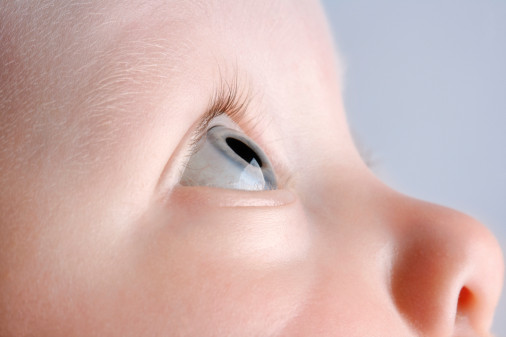Baby eye colour is likely to change over time. Baby eye colour
is determined by a substance called melanin. Melanin is a dark
pigment contained in the iris, the structure that controls how much
light is allowed into the eye.

Given below is information on the most
common as well as the most rare eye colors in human beings.
Most Common Eye
Colours
Brown
The eye colour that can be described as
the most common amongst human beings is brown, with the exception of
countries around the Baltic Sea. It is the result of the presence of
large amounts of melanin within the iris stroma. People who have very
dark brown irises might give the appearance of having black eyes.
Hazel
Another common eye colour is hazel.
Hazel eyes are the result of a combination of a Rayleigh scattering
and a modest amount of melanin in the front border layer of the iris.
Hazel eye colour has also been defined as the medium-colour between
light brown and dark green. Hazel is common amongst people in America
and Europe, while rare in African, Middle Eastern and Asian people.
Gray
Gray eye colour is considered to be a
darker shade of blue (like blue-green). This eye colour is related to
low melanin in the iris and is related to scant pigmentation
throughout the body (like pale skin, light hair, etc). Gray eyes have
been found to reveal small amounts of yellow and brown colour in the
iris. European people, belonging to countries like Russia, Finland
and the Baltic States, often have grey eyes, while those in Southeast
Asia rarely have this eye colour. Gray eyes might seem to change
between the shades of blue, green and grey, mainly because of the
lighting changes.
Blue
Blue eyes are quite common amongst
people, especially those born in Germany, Netherlands, Iceland,
Austria, Sweden, Norway, Denmark, Finland, and Estonia. The reason
behind this eye colour is low amounts of melanin within the iris
stroma. In Central Asia and Middle East, blue eyes are pretty rare.
Since the production of melanin generally increases during the first
few years of life, the blue eyes of some babies might darken as they
get older.
Rarest Eye Colours
Amber
Amber eyes can be defined as the ones
having a strong yellowish/golden and russet/coppery tint. The reason
behind amber eyes is the deposition of ‘lipochrome’, the yellow
pigment, in the iris. It is a very rare eye colour and also known as
‘wolf eyes’, since amber eye colour is very common in wolves.
Green
Green eye colour is amongst the rarest
eye colour, with only 1-2% of the world's population born with green
eyes. The reason for green eye colour is the production of moderate
amounts of melanin. People born in Northern Europe and Nordic
countries (like Iceland, Sweden, Denmark, Finland, Norway, Germany,
and Netherlands) usually have green eyes.
Violet
Violet eyes are mainly seen in albinos.
In effect, the eyes of some albinos appear to be violet because of
the mixing of red and blue reflections. Violet eyes are either a form
of blue eyes or a mutation.
Red
Red is probably the rarest eye colour
amongst the human population of the world. It is mainly seen in case
of albinos and is the result of either large quantities of the
‘normally scarce’ red areas in the eyes or a small leakage of
blood into the iris.
Black
Black is amongst the rarest eye colours in the world. Most of the people who appear to have black eyes have, in fact, extremely dark brown eyes that seem to be black.
The classroom version of eye colour genetics generally holds
true, that brown eye genes are dominant over green eye genes, and
both brown and green eye genes are dominant over blue. However, the
biological reality is not as simple as that because eye colour is a
polygenetic genetic, it involves many different genes, some of which
remain unknown to science. And each gene comes in two versions which
leads to a considerable amount of variation. So for example, it is
possible for two blue-eyed parents to have a child with brown
eyes.

No comments :
Post a Comment